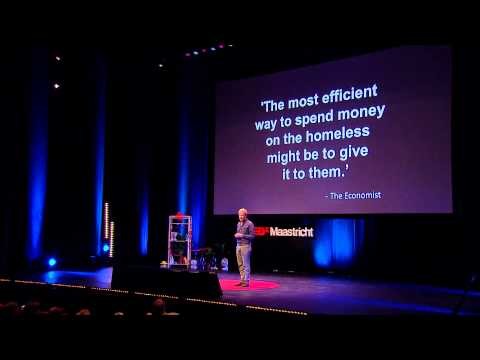London, May 2009. A small experiment involving thirteen homeless men takes off. They are street veterans. Some of them have been sleeping on the cold tiles of The Square Mile, the financial center of Europe, for more than forty years. Their presence is far from cheap. Police, legal services, healthcare: the thirteen cost taxpayers hundreds of thousands of pounds. Every year.
That spring, a local charity takes a radical decision. The street veterans are to become the beneficiaries of an innovative social experiment. No more food stamps, food kitchen dinners or sporadic shelter stays for them. The men will get a drastic bailout, financed by taxpayers. They’ll each receive 3,000 pounds, cash, with no strings attached. The men are free to decide what to spend it on; counseling services are completely optional. No requirements, no hard questions. The only question they have to answer is:
What do you think is good for you?
Gardening classes
‘I didn’t have enormous expectations,’ an aid worker recalls.
Yet the desires of the homeless men turned out to be quite modest. A phone, a passport, a dictionary - each participant had his own ideas about what would be best for him. None of the men wasted their money on alcohol, drugs or gambling. On the contrary, most of them were extremely frugal with the money they had received. On average, only 800 pounds had been spent at the end of the first year.
Simon’s life was turned upside down by the money. Having been addicted to heroin for twenty years, he finally got clean and began with gardening classes. ‘For the first time in my life everything just clicked, it feels like now I can do something’, he says. ‘I’m thinking of going back home. I’ve got two kids.’
A year after the experiment had started, eleven out of thirteen had a roof above their heads. They accepted accommodation, enrolled in education, learnt how to cook, got treatment for drug use, visited their families and made plans for the future. ‘I loved the cold weather,’ one of them remembers. ‘Now I hate it.’ After decades of authorities’ fruitless pushing, pulling, fines and persecution, eleven notorious vagrants finally moved off the streets.
Costs? 50,000 pounds a year, including the wages of the aid workers. In addition to giving eleven individuals another shot at life, the project had saved money by a factor of at least 7. Even The Economist concluded:
‘The most efficient way to spend money on the homeless might be to give it to them.’
Santa exists
We tend to presume that the poor are unable to handle money. If they had any, people reason, they would probably spend it on fast food and cheap beer, not on fruit or education. This kind of reasoning nourishes the myriad social programs, administrative jungles, armies of program coordinators and legions of supervising staff that make up the modern welfare state. Since the start of the crisis, the number of initiatives battling fraud with benefits and subsidies has surged.
People have to ‘work for their money,’ we like to think. In recent decades, social welfare has become geared toward a labor market that does not create enough jobs. The trend from ‘welfare’ to ‘workfare’ is international, with obligatory job applications, reintegration trajectories, mandatory participation in ‘voluntary’ work. The underlying message: Free money makes people lazy.
Except that it doesn’t.
Meet Bernard Omandi. For years he worked in a quarry, somewhere in the inhabitable West of Kenya. Bernard made $2 a day, until one morning, he received a remarkable text message. ‘When I saw the message, I jumped up’, he later recalled. And with good reason: $500 had just been deposited into his account. For Bernard, the sum amounted to almost a year’s salary.
A couple of months later a New York Times reporter walked around his village. It was like everyone had won the jackpot - but no one had wasted the money. People were repairing their homes and starting small businesses. Bernard was making $6 to $9 a day driving around on his new Bajai Boxer, an Indian motor cycle which he used to provide transportation for local residents. ‘This puts the choice in the hands of the poor, and not me,’ Michael Faye, co-founder of GiveDirectly, the coordinating organization, said. ‘The truth is, I don’t think I have a very good sense of what the poor need.’ When Google had a look at his data, the company immediately decided to donate $2.5 million.
Bernard and his fellow villagers are not the only ones who got lucky. In 2008, the Ugandan government gave about $400 to almost 12,000 youths between the ages of 16 and 35. Just money – no questions asked. And guess what? The results were astounding. A mere four years later, the youths’ educational and entrepreneurial investments had caused their incomes to increase by almost 50%. Their chances of being employed had increased by 60%.
Another Ugandan program awarded $150 to 1,800 poor women in the North of the country. Here, too, incomes went up significantly. The women who were supported by an aid worker were slightly better off, but later calculations proved that the program would have been even more effective had the aid workers’ salary simply been divided among the women as well.
Studies from all over the world drive home the exact same point: free money helps. Proven correlations exist between free money and a decrease in crime, lower inequality, less malnutrition, lower infant mortality and teenage pregnancy rates, less truancy, better school completion rates, higher economic growth and emancipation rates. ‘The big reason poor people are poor is because they don’t have enough money’, economist Charles Kenny, a fellow at the Center for Global Development, dryly remarked last June. ‘It shouldn’t come as a huge surprise that giving them money is a great way to reduce that problem.’
Free-money programs have flourished in the past decade
In the 2010 work Just Give Money to the Poor, researchers from the Brooks World Poverty Institute, an independent institute based at the University of Manchester, give numerous examples of money being scattered successfully. In Namibia, malnourishment, crime and truancy fell 25 percent, 42 percent and nearly 40 percent respectively. In Malawi, school enrollment of girls and women rose 40 percent in conditional and unconditional settings. From Brazil to India and from Mexico to South Africa, free-money programs have flourished in the past decade. While the Millenium Development Goals did not even mention the programs, by now more than 110 million families in at least 45 countries benefit from them.
Researchers sum up the programs’ advantages: (1) households make good use of the money, (2) poverty decreases, (3) long-term benefits in income, health, and tax income are remarkable, (4) there is no negative effect on labor supply – recipients do not work less, and (5) the programs save money. Why would we send well-paid foreigners in SUVs when we could just give cash? This would also diminish risk of corrupt officials taking their share. Free money stimulates the entire economy: consumption goes up, resulting in more jobs and higher incomes.
‘Poverty is fundamentally about a lack of cash. It’s not about stupidity,’ author Joseph Hanlon remarks. ‘You can’t pull yourself up by your bootstraps if you have no boots.’
An old idea
Free money: the idea has been propagated by some of history’s greatest minds. Thomas More dreamt of it in his famous Utopia (1516). Countless economists and philosophers, many of them Nobel laureates, would follow suit. Proponents cannot be pinned down on the political spectrum: it appeals to both left- and right-wing thinkers. Even the founders of neoliberalism, Friedrich Hayek and Milton Friedman supported the idea. Article 25 of the Universal Declaration of Human Rights (1948) directly refers to it.
The basic income.
And not just for a few years, in developing countries only, or merely for the poor – but free money as a basic human right for everyone. The philosopher Philippe van Parijs has called it ‘the capitalist road to communism.’ A monthly allowance, enough to live off, without any outside control on whether you spend it well or whether you even deserve it. No jungle of extra charges, benefits, rebates - all of which cost tons to implement. At most with some extras for the elderly, unemployed and disabled.
The basic income - it is an idea whose time has come.
Mincome, Canada
In an attic of a warehouse in Winnipeg, Canada, 1,800 boxes are accumulating dust. The boxes are filled with data – tables, graphs, reports, transcripts – from one of the most fascinating social experiments in postwar history: Mincome.
Evelyn Forget, professor at the University of Manitoba, heard about the experiment in 2004. For five years, she courted the Canadian National Archive to get access to the material. When she was finally allowed to enter the attic in 2009, she could hardly believe her eyes: this archive stored a wealth of information on the application of Thomas More’s age-old ideal.
One of the almost 1,000 interviews tucked away in boxes was with Hugh and Doreen Henderson. Thirty-five years earlier, when the experiment took off, he worked as a school janitor and she took care of their two kids. Life had not been easy for them. Doreen grew vegetables and they kept their own chickens in order to secure their daily food supply.
From that moment, money was no longer a problem
One day the doorbell rang. Two men wearing suits made an offer the Henderson family couldn’t refuse. ‘We filled out forms and they wanted to see our receipts’, Doreen remembers. From that moment, money was no longer a problem for the Henderson family. Hugh and Doreen entered Mincome – the first large-scale social experiment in Canada and the biggest experiment implementing a basic income ever conducted.
In March 1973 the governor of the province had decided to reserve $17 million for the project. The experiment was to take place in Dauphin, a small city with 13,000 inhabitants north of Winnipeg. The following spring researchers began to crowd the town to monitor the development of the pilot. Economists were keeping track of people’s working habits, sociologists looked into the experiment’s effects on family life and anthropologists engaged in close observation of people’s individual responses.
The basic income regulations had to ensure no one would drop below the poverty line. In practice this meant that about a 1,000 families in Dauphin, covering 30% of the total population, received a monthly paycheck. For a family of five, the amount would come down to $18,000 a year today (figure corrected for inflation). No questions asked.
Four years passed until a round of elections threw a spanner in the works. The newly elected conservative government didn’t like the costly experiment that was financed by the Canadian taxpayer for 75%. When it turned out that there was not even enough money to analyze the results, the initiators decided to pack the experiment away. In 1,800 boxes.
The Dauphin population was bitterly disappointed. At its start in 1974, Mincome was seen as a pilot project that might eventually go national. But now it seemed to be destined for oblivion. ‘Government officials opposed to Mincome didn’t want to spend more money to analyze the data and show what they already thought: that it didn’t work,’ one of the researchers remembers. ‘And the people who were in favor of Mincome were worried because if the analysis was done and the data wasn’t favorable then they would have just spent another million dollars on analysis and be even more embarrassed.’
When professor Forget first heard of Mincome, no one knew how the experiment had truly worked out. However, 1970 had also been the year Medicare, the national health insurance system, had been implemented. The Medicare archives provided Forget with a wealth of data allowing her to compare Dauphin to surrounding towns and other control groups. For three years, she analyzed and analyzed, consistently coming to the same conclusion:
Mincome had been a great success.
From experiment to law
‘Politicians feared that people would stop working, and that they would have lots of children to increase their income,’ professor Forget says. Yet the opposite happened: the average marital age went up while the birth rate went down. The Mincome cohort had better school completion records. The total amount of work hours decreased by only 13%. Breadwinners hardly cut down on their hours, women used the basic income for a couple of months of maternity leave and young people used it to do some extra studying.
Forget’s most remarkable discovery is that hospital visits went down by 8,5%. This amounted to huge savings (in the United States it would be more than $200 billion a year now). After a couple of years, domestic violence rates and mental health also saw improvement. Mincome made the entire town healthier. The basic income continued to influence following generations, both in terms of income and health.
Dauphin, the town with no poverty, was one of five North-American basic income experiments. Four U.S. projects preceded it. Today, few people know how close the US was in the sixties to implementing a solid social welfare system that could stand the comparison with that of most Western-European countries nowadays. In 1964, president Lyndon B. Johnson declared a ‘war on poverty.’ Democrats and Republicans were united in their ambition to fundamentally reform social security. But first more testing was needed.
Several tens of millions were made available to test the effects of a basic income among 10,000 families in Pennsylvania, Indiana, North Carolina, Seattle and Denver. The pilots were the first large-scale social experiments differentiating between various test and control groups. The researchers were trying to find the answers to three questions. 1: Does a basic income make people work significantly less? 2: If so, will it make the program unaffordable? 3: And would it consequently become politically unattainable?
The answers: no, no and yes.
The decrease in working hours turned out to be limited. ‘The ‘laziness’ contention is just not supported by our findings’, the chief data analyst of the Denver experiment said. ‘There is not anywhere near the mass defection the prophets of doom predicted.’ On average, the decline in work hours amounted to 9 percent per household. Like in Dauphin, the majority of this drop was caused by young mothers and students in their twenties.
‘These declines in hours of paid work were undoubtedly compensated in part by other useful activities, such as search for better jobs or work in the home,’ an evaluative report of a Seattle project concluded. A mother who had never finished high school got a degree in psychology and went on to a career in research. Another woman took acting classes, while her husband started composing. ‘We’re now self-sufficient, income-earning artists’, they told the researchers. School results improved in all experiments: grades went up and dropout rates went down. Nutrition and health data were also positively affected – for example, the birth weight of newborn babies increased.
For a while, it seemed like the basic income would fare well in Washington.
WELFARE REFORM IS VOTED IN HOUSE, a NYT headline on April 17, 1970 read. An overwhelming majority had endorsed President Nixon’s proposal for a modest basic income. But once the proposal got to the Senate, doubts returned. ‘This bill represents the most extensive, expensive and expansive welfare legislation ever handled by the Committee on Finance,’ one of the senators said.
Then came that fatal discovery: the number of divorces in Seattle had gone up by more than 50%. This percentage made the other, positive results seem utterly uninteresting. It gave rise to the fear that a basic income would make women much too independent. For months, the law proposal was sent back and forth between the Senate and the White House, eventually ending in the dustbin of history.
Later analysis would show that the researchers had made a mistake – in reality the number of divorces had not changed.
Futile, dangerous and perverse
‘It Can Be Done! Conquering Poverty in the US by 1976’, James Tobin, who would go on to win a Nobel Prize, wrote in 1967. At that time, almost 80% of the American population was in favor of adopting a small basic income. Nevertheless, Ronald Reagan sneered years later: ‘In the sixties we waged a war on poverty, and poverty won.’
Almost 80% of the American population was in favor of adopting a small basic income
Milestones of civilization are often first considered impossible utopias. Albert Hirschman, one of the great sociologists of the previous century, wrote that utopian dreams are usually rebutted on three grounds: futility (it is impossible), danger (the risks are too big) and perversity (its realization will result in the opposite: a dystopia). Yet Hirschmann also described how, once implemented, ideas previously considered utopian are quickly accepted as normal.
Not so long ago, democracy was a grand utopian ideal. From the radical philosopher Plato to the conservative aristocrat Joseph de Maistre, most intellectuals considered the masses too stupid for democracy. They thought that the general will of the people would quickly degenerate into some general’s will instead. Apply this kind of reasoning to the basic income: it would be futile because we would not be able to afford it, dangerous because people would stop working, and perverse because we would only have to work harder to clean up the mess it creates.
But wait a second.
Futile? For the first time in history we are rich enough to finance a robust basic income. It would allow us to cut most of the benefits and supervision programs that the current social welfare system necessitates. Many tax rebates would be redundant. Further financing could come from (higher) taxing of capital, pollution and consumption.
Eradicating poverty in the United States would cost $175 billion – a quarter of the country’s $700 billion military budget.
A quick calculation. The country I live in, Holland, has 16.8 million inhabitants. Its poverty line is set at $1,300 a month. This would make for a reasonable basic income. Some simple math would set the cost on 193.5 billion euro annually, about 30% of our national GDP. That’s an astronomically high figure. But remember: the government already controls more than half of our GDP. It does not keep the Netherlands from being one of the richest, most competitive and happiest countries in the world.
The basic income that Canada experimented with – free money as a right for the poor – would be much cheaper. Eradicating poverty in the United States would cost $175 billion, economist Matt Bruenig recently calculated – a quarter of the country’s $700 billion military budget. Still, a system that only helps the poor confirms the divide with the well-to-do. ‘A policy for the poor is a poor policy,’ Richard Titmuss, the mastermind of the British welfare state, once wrote. A universal basic income, on the other hand, can count on broad support since everyone benefits.
Dangerous? Indeed, we would work a little less. But that’s a good thing, with the potential of working wonders for our personal and family lives. A small group of artists and writers (‘all those whom society despises while they are alive and honors when they are dead’ – Bertrand Russell) may actually stop doing paid work. Nevertheless, there is plenty of evidence that the great majority of people, regardless of what grants they would receive, want to work. Unemployment makes us very unhappy.
One of the perks of the basic income is that it stimulates the ‘working poor’ – who are, under the current system, more secure receiving welfare payments - to look for jobs. The basic income can only improve their situation; the grant would be unconditional. Minimum wage could be abolished, improving employment opportunities at the lower ends of the labor market. Age would no longer need to form an obstacle to finding and keeping employment (as older employees would not necessarily earn more) thereby boosting overall labor participation.
The welfare state was built to provide security but degenerated in a system of shame
Perverse? On the contrary, over the last decades our social security systems have degenerated into perverse systems of social control. Government officials spy on people receiving welfare to make sure they are not wasting their money. Inspectors spend their days coaching citizens to help them make sense of all the necessary paperwork. Thousands of government officials are kept busy keeping an eye on this fraud-sensitive bureaucracy. The welfare state was built to provide security but degenerated in a system of distrust and shame.
Think different
It has been said before. Our welfare state is out of date, based on a time in which men were the sole breadwinners and employees stayed with one company for their entire careers. Our pension system and unemployment protection programs are still centered around those lucky enough to have steady employment. Social security is based on the wrong premise that the economy creates enough jobs. Welfare programs have become pitfalls instead of trampolines.
Never before has the time been so ripe to implement a universal and unconditional basic income. Our ageing societies are challenging us to keep the elderly economically active for as long as possible. An increasingly flexible labor market creates the need for more security. Globalization is eroding middle-class wages worldwide. Women’s emancipation will only be completed when a greater financial independence is possible for all. The deepening divide between the low- and highly educated means that the former are in need of extra support. The rise of robots and the increasing automatization of our economy could cost even those at the top of the ladder their jobs.
Legend has it that while Henry Ford II was giving a tour around a new, fully automatic factory to union leader Walter Reuther in the 1960s, Ford joked:
‘Walter, how are you going to get those robots to pay your union dues?’
Reuther is said to have replied:
‘Henry, how are you going to get them to buy your cars?’
A world where wages no longer rise still needs consumers. In the last decades, middle-class purchasing power has been maintained through loans, loans and more loans. The Calvinistic reflex that you have to work for your money has turned into a license for inequality.
No one is suggesting societies the world over should implement an expensive basic income system in one stroke. Each utopia needs to start small, with experiments that slowly turn our world upside down — like the one four years ago in the City of London. One of the aid workers later recalled: ‘It’s quite hard to just change overnight the way you’ve always approached this problem. These pilots give us the opportunity to talk differently, think differently, describe the problem differently.’
That is how all progress begins.
My TEDx Talk on the basic income
 Utopia for Realists, the book
This article has since developed into a book, published by De Correspondent. It's called Utopia for Realists: The Case for a Universal Basic Income, Open Borders, and a 15-hour Workweek. Out now!
Utopia for Realists, the book
This article has since developed into a book, published by De Correspondent. It's called Utopia for Realists: The Case for a Universal Basic Income, Open Borders, and a 15-hour Workweek. Out now!

An edited version of this article was published in The Washington Post.
Translated from Dutch by Tabitha Speelman.



